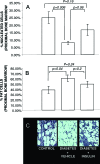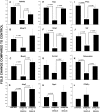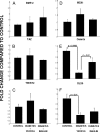Runt-related transcription factor 2 (RUNX2) and RUNX2-related osteogenic genes are down-regulated throughout osteogenesis in type 1 diabetes mellitus
- PMID: 18162513
- PMCID: PMC2276714
- DOI: 10.1210/en.2007-1408
Runt-related transcription factor 2 (RUNX2) and RUNX2-related osteogenic genes are down-regulated throughout osteogenesis in type 1 diabetes mellitus
Abstract
Type 1 diabetes mellitus is associated with a number of disorders of skeletal health, conditions that rely, in part, on dynamic bone formation. A mouse model of distraction osteogenesis was used to study the consequences of streptozotocin-induced diabetes and insulin treatment on bone formation and osteoblastogenesis. In diabetic mice compared with control mice, new bone formation was decreased, and adipogenesis was increased in and around, respectively, the distraction gaps. Although insulin treatment restored bone formation to levels observed in nondiabetic control mice, it failed to significantly decrease adipogenesis. Molecular events altered during de novo bone formation in untreated type 1 diabetes mellitus, yet restored with insulin treatment were examined so as to clarify specific osteogenic genes that may contribute to diabetic bone disease. RNA from distraction gaps was analyzed by gene microarray and quantitative RT-PCR for osteogenic genes of interest. Runt-related transcription factor 2 (RUNX2), and several RUNX2 target genes, including matrix metalloproteinase-9, Akp2, integrin binding sialoprotein, Dmp1, Col1a2, Phex, Vdr, osteocalcin, and osterix, were all significantly down-regulated in the insulin-deficient, hyperglycemic diabetic animals; however, insulin treatment of diabetic animals significantly restored their expression. Expression of bone morphogenic protein-2, transcriptional coactivator with PDZ-binding motif, and TWIST2, all important regulators of RUNX2, were not impacted by the diabetic condition, suggesting that the defect in osteogenesis resides at the level of RUNX2 expression and its activity. Together, these data demonstrate that insulin and/or glycemic status can regulate osteogenesis in vivo, and systemic insulin therapy can, in large part, rescue the diabetic bone phenotype at the tissue and molecular level.
Figures




Similar articles
-
Insulin-dependent diabetes mellitus decreases osteoblastogenesis associated with the inhibition of Wnt signaling through increased expression of Sost and Dkk1 and inhibition of Akt activation.Int J Mol Med. 2011 Sep;28(3):455-62. doi: 10.3892/ijmm.2011.697. Epub 2011 May 11. Int J Mol Med. 2011. PMID: 21567076
-
BMP2 commitment to the osteogenic lineage involves activation of Runx2 by DLX3 and a homeodomain transcriptional network.J Biol Chem. 2006 Dec 29;281(52):40515-26. doi: 10.1074/jbc.M604508200. Epub 2006 Oct 23. J Biol Chem. 2006. PMID: 17060321
-
Coordinated activation of notch, Wnt, and transforming growth factor-beta signaling pathways in bone morphogenic protein 2-induced osteogenesis. Notch target gene Hey1 inhibits mineralization and Runx2 transcriptional activity.J Biol Chem. 2004 Sep 3;279(36):37704-15. doi: 10.1074/jbc.M403813200. Epub 2004 Jun 2. J Biol Chem. 2004. PMID: 15178686
-
Down-regulation of miR-340-5p promoted osteogenic differentiation through regulation of runt-related transcription factor-2 (RUNX2) in MC3T3-E1 cells.Bioengineered. 2021 Dec;12(1):1126-1137. doi: 10.1080/21655979.2021.1905259. Bioengineered. 2021. PMID: 33818278 Free PMC article.
-
Networks and hubs for the transcriptional control of osteoblastogenesis.Rev Endocr Metab Disord. 2006 Jun;7(1-2):1-16. doi: 10.1007/s11154-006-9001-5. Rev Endocr Metab Disord. 2006. PMID: 17051438 Review.
Cited by
-
FFA-ROS-P53-mediated mitochondrial apoptosis contributes to reduction of osteoblastogenesis and bone mass in type 2 diabetes mellitus.Sci Rep. 2015 Jul 31;5:12724. doi: 10.1038/srep12724. Sci Rep. 2015. PMID: 26226833 Free PMC article.
-
Local Application of Isogenic Adipose-Derived Stem Cells Restores Bone Healing Capacity in a Type 2 Diabetes Model.Stem Cells Transl Med. 2016 Jun;5(6):836-44. doi: 10.5966/sctm.2015-0158. Epub 2016 Apr 21. Stem Cells Transl Med. 2016. PMID: 27102648 Free PMC article.
-
Estrogen Deficiency Exacerbates Type 1 Diabetes-Induced Bone TNF-α Expression and Osteoporosis in Female Mice.Endocrinology. 2017 Jul 1;158(7):2086-2101. doi: 10.1210/en.2016-1821. Endocrinology. 2017. PMID: 28419209 Free PMC article.
-
Skeletal manifestations in a streptozotocin-induced C57BL/6 model of Type 1 diabetes.Bone Rep. 2022 Aug 1;17:101609. doi: 10.1016/j.bonr.2022.101609. eCollection 2022 Dec. Bone Rep. 2022. PMID: 35941910 Free PMC article.
-
SGLT2 inhibitor therapy improves blood glucose but does not prevent diabetic bone disease in diabetic DBA/2J male mice.Bone. 2016 Jan;82:101-7. doi: 10.1016/j.bone.2015.07.025. Epub 2015 Jul 23. Bone. 2016. PMID: 26211996 Free PMC article.
References
-
- Ahmed ML, Connors MH, Drayer NM, Jones JS, Dunger DB 1998 Pubertal growth in IDDM is determined by HbA1c levels, sex, and bone age. Diabetes Care [Erratum (1998) 21:1382] 21:831–835 - PubMed
-
- Salerno M, Argenziano A, Di Maio S, Gasparini N, Formicola S, De Filippo G, Tenore A 1997 Pubertal growth, sexual maturation, and final height in children with IDDM. Effects of age at onset and metabolic control. Diabetes Care 20:721–724 - PubMed
-
- Hampson G, Evans C, Petitt RJ, Evans WD, Woodhead SJ, Peters JR, Ralston SH 1998 Bone mineral density, collagen type 1 α 1 genotypes and bone turnover in premenopausal women with diabetes mellitus. Diabetologia 41:1314–1320 - PubMed
-
- Heap J, Murray MA, Miller SC, Jalili T, Moyer-Mileur LJ 2004 Alterations in bone characteristics associated with glycemic control in adolescents with type 1 diabetes mellitus. J Pediatr 144:56–62 - PubMed
-
- Kayath MJ, Dib SA, Vieira JG 1994 Prevalence and magnitude of osteopenia associated with insulin-dependent diabetes mellitus. J Diabetes Complications 8:97–104 - PubMed
Publication types
MeSH terms
Substances
Grants and funding
LinkOut - more resources
Full Text Sources
Medical
Miscellaneous

